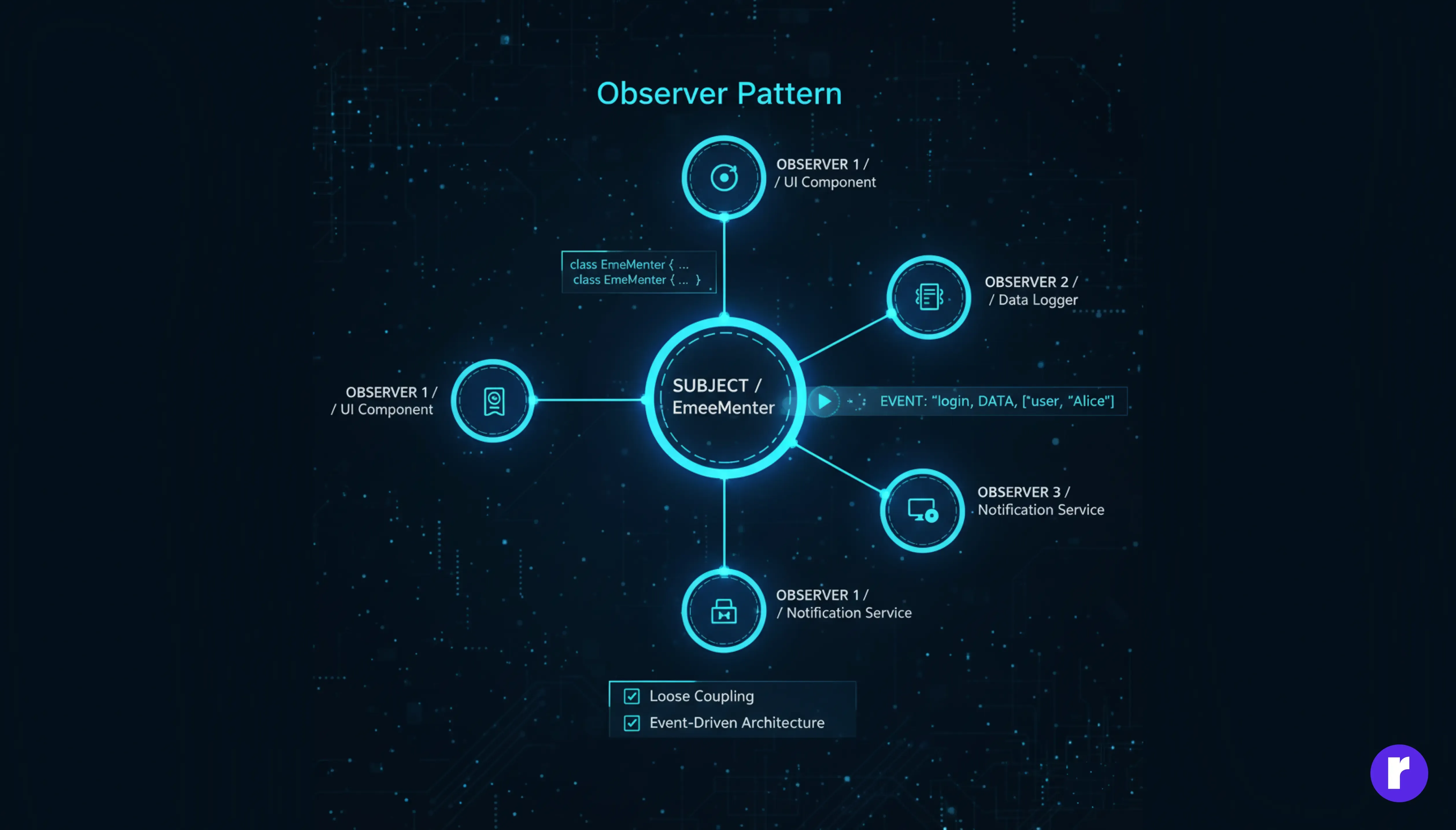Modern JavaScript Patterns for Efficient Development

Written by
Ankit Godara
Front End Developer
Vishal Chanda
Front End Developer
Table of contents
Build with Radial Code
JavaScript has evolved from being just a browser scripting language to the backbone of modern web applications. From front-end interfaces to back-end servers, and even mobile apps — JavaScript is everywhere..
As projects become larger, developers face a challenge: keeping the code organized, reusable, and efficient. This is where design patterns help. They’re time-tested solutions for recurring coding problems, helping you structure your projects in a cleaner, maintainable way.
Module Pattern
The Module Pattern helps you organize related code into independent, self-contained units. It keeps variables and methods private while exposing only what’s necessary. This structure makes large applications easier to manage and avoids global namespace pollution.
Example:
const CounterModule = (() => {
let count = 0;
const increment = () => count++;
const decrement = () => count--;
const getCount = () => count;
return {
increment,
decrement,
getCount
};
})();
CounterModule.increment();
console.log(CounterModule.getCount()); // 1Revealing Module Pattern
The Revealing Module Pattern improves readability by clearly defining what’s public at the end of the module. Everything is written privately, and only selected functions or variables are “revealed.”
Example:
const UserModule = (() => {
let username = "Guest";
function setName(name) {
username = name;
}
function getName() {
return username;
}
return {
setName,
getName
};
})();
UserModule.setName("Sahil");
console.log(UserModule.getName()); // "Sahil"By revealing the public methods in one place, it becomes much easier to understand the structure. This is often used in dashboards or web apps where state management and data handling are important. Learn JavaScript fundamentals Here.
Observer Pattern

The Observer Pattern (or Publish–Subscribe) enables communication between different parts of your app without them directly depending on each other. One object (the “subject”) notifies others (“observers”) when something changes. This makes it a key part of event-driven programming, used in frameworks like React, Vue, and Angular. For example, when a component’s state changes, other components automatically update.
Why the Observer Pattern is Useful:
- Promotes loose coupling between components
- Makes applications more modular and maintainable
- Ideal for real-time updates and live data flows
- Forms the backbone of state management systems like Redux and RxJS
- Reduces repetitive code by automating change notifications
- Enhances scalability in large applications with multiple interconnected parts
Singleton Pattern
The Singleton Pattern ensures that only one instance of a class or object exists across your application. This is useful for shared services like configurations, database connections, or logging.
Example:
class DatabaseConnection {
constructor() {
if (DatabaseConnection.instance) {
return DatabaseConnection.instance;
}
this.connection = "Connected to DB";
DatabaseConnection.instance = this;
}
}
const db1 = new DatabaseConnection();
const db2 = new DatabaseConnection();
console.log(db1 === db2); // true
Here, both variables reference the same instance — meaning you’ll never accidentally create multiple database connections.
Singletons are widely used for global state managers, caching systems, or configuration files that must remain consistent.
Continue your learning journey at Radial Code .
Factory Pattern
The Singleton Pattern is all about simplifying object creation. Instead of manually constructing objects using new every time, the factory function handles it for you — based on input or type.
Example:
class Developer {
constructor(name) {
this.name = name;
this.role = "Developer";
}
}
class Tester {
constructor(name) {
this.name = name;
this.role = "Tester";
}
}
class EmployeeFactory {
create(name, type) {
switch (type) {
case "developer":
return new Developer(name);
case "tester":
return new Tester(name);
default:
throw new Error("Unknown employee type — please provide a valid one.");
}
}
}
const factory = new EmployeeFactory();
const dev = factory.create("Amit", "developer");
console.log(dev); // Developer { name: 'Amit', role: 'Developer' }This pattern is perfect for cases where you need different object types created dynamically, such as form builders, UI components, or API models.
Strategy Pattern
The Strategy Pattern is all about flexibility — it lets you define a family of algorithms (or “strategies”) and switch between them dynamically at runtime. Instead of cluttering your codebase with long chains of if or switch statements, you can plug in different behaviors seamlessly based on context.
Think of it like changing the way your app thinks without touching its core logic — much like a game character switching between combat styles or an app offering multiple payment methods.
Example:
class PaymentStrategy {
pay(amount) {
throw new Error("Payment method not defined. Please extend PaymentStrategy.");
}
}
class CreditCardPayment extends PaymentStrategy {
pay(amount) {
console.log(`✅ Paid ₹${amount} via Credit Card.`);
}
}
class PayPalPayment extends PaymentStrategy {
pay(amount) {
console.log(`💰 Paid ₹${amount} through PayPal.`);
}
}
class UpiPayment extends PaymentStrategy {
pay(amount) {
console.log(`📱 Paid ₹${amount} using UPI.`);
}
}
class PaymentContext {
setStrategy(strategy) {
if (!(strategy instanceof PaymentStrategy)) {
throw new Error("Invalid payment strategy selected!");
}
this.strategy = strategy;
}
pay(amount) {
if (!this.strategy) {
throw new Error("No active payment method! Please select one before paying.");
}
this.strategy.pay(amount);
}
}
// Usage
const payment = new PaymentContext();
payment.setStrategy(new UpiPayment());
payment.pay(1500); // 📱 Paid ₹1500 using UPI.The Strategy Pattern is especially useful in:
- E-commerce apps (switching between payment gateways)
- Game development (toggling AI or player behavior)
- Data processing systems (applying different sorting or filtering algorithms)
Conclusion
Modern JavaScript patterns are more than just coding techniques—they represent a mindset for writing better, scalable, and future-proof applications. From foundational concepts like Modules and Observers to advanced paradigms like Functional Programming and Async Patterns, each serves a purpose in making your code cleaner, reusable, and maintainable
